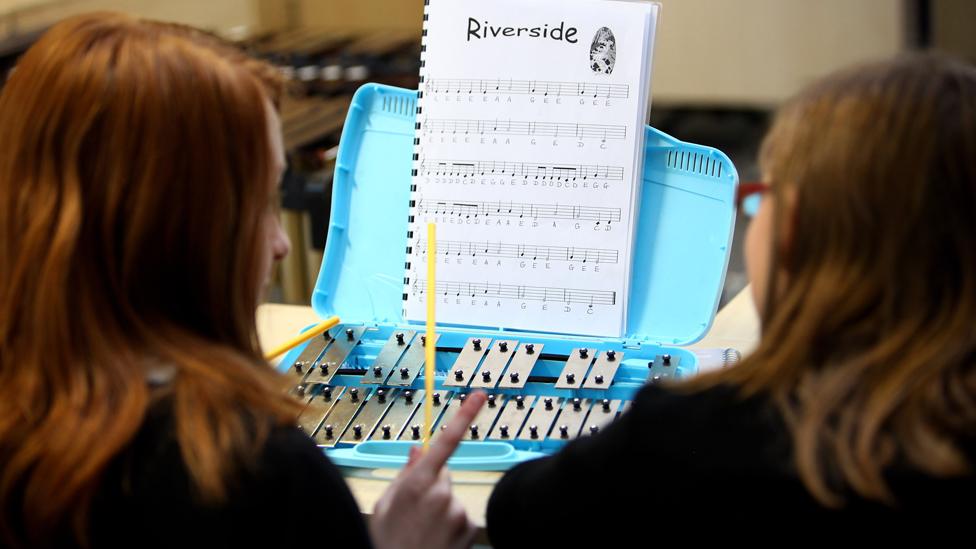What are the alternatives to your local school in Scotland?
- Published
An independent review has concluded that two schools built on a former industrial site in Coatbridge are safe after finding no connection with health concerns, external.
However, some parents remain concerned and have said they do not want to send their children back to the school.
There can be a variety of reasons why parents may not want their child to go to the local school - but what are their options?
Option 1: A placing request

In Scotland, pupils are automatically entitled to a place at the secondary school covering the area where they live. If they want to go to another school instead, they make a placing request.
Normally the reasons behind the placing request would be framed as positives, whether they are about personal issues or the school. These could include a sibling attending the same school, childcare arrangements if a relative lives nearby, or availability of a specific subject.
However, inevitably, some requests do stem from actual dissatisfaction (fairly or unfairly) with the existing school - or a belief (rightly or wrongly) that the other school is better.
Inevitably, schools with good reputations often get a number of placing requests.
If a parent makes a placing request, there is no compulsion on the local authority to agree - it basically depends on whether the school can take in the child.

Schools will often have published policies on how they deal with placing requests, especially if they receive more placing requests than they are able to accommodate. For instance, a Catholic school may actively prioritise Catholic children from outside its catchment area over those from other denominations.
Free school transport is not usually available for children attending schools through placing requests. Families would need to make their own travel arrangements or be prepared to pay bus fares.
As a general rule, placing requests can be realistic options in urban areas. The nearest school may be relatively close, so the question is really about whether a place might be available and about additional transport costs. However, in rural areas the nearest school may be so far away that it would be impractical to travel there each day.
Many council websites will have information on how to make a placing request.
Separately, parents of children with significant additional support needs may ask for a place in a specialist school if they do not believe that support within a mainstream environment is the best option. This may be one run by the council itself or one in the independent sector with funding provided for the child by the local authority.
Option 2: The independent sector

A parent may apply for a place at an independent school. Unless someone is prepared to consider a boarding school, the option of the independent sector is only practical for those who live within a reasonable daily travelling time.
Cost is, of course, an important factor here - but independent schools are keen to stress that many of their pupils do not come from wealthy backgrounds.
Many families pay large fees but, in return for their charitable status, independent schools provide some places where the fees are significantly lower or even non-existent.
According to the Scottish Council for Independent Schools, in 2016-17 around one pupil in four received financial help with their fees and 600 students received free places.
Generally speaking, independent schools are at least partially selective and there is competition for places - perhaps through an interview or entrance test.
It's worth noting that pupils join independent schools at a whole range of points, not just at the start of their education or the start of secondary school.
Option 3: Home education

Parents have a right to teach a child at home rather than send them to school - and a local authority would need to have a reason to actively withhold consent if a parent wanted to do this.
However, the council also has to ensure a child is receiving an adequate education.
If a child is currently at a state school, the parent normally needs consent to teach them at home - although they would not initially require permission to withdraw the child from school.
Consent would not be required if a parent had decided against sending their child to a state school in the first place.
If consent is given, the council would check - normally once a year - that teaching at home is of a high standard.
If the council believes the child is not being taught to a good standard, it can issue an attendance order - which would compel a child to attend school.
Especially in the case of secondary education, the local authority is likely to be interested in the opportunities which are being afforded to a young person. For example, are they getting the chance to obtain qualifications? These can be done, in theory at least, through correspondence courses or local colleges.
In other words, the council would wish to be assured that a child withdrawn from school is genuinely being home educated and not simply being kept out of school.
In Glasgow, for instance, approximately 90 children are being home-educated.
Doing this properly, to the satisfaction of the local authority, is a considerable commitment for the family and not something which can be undertaken lightly.